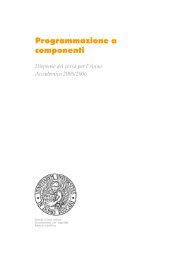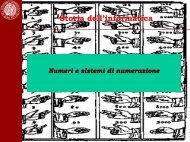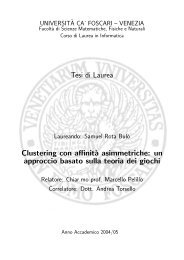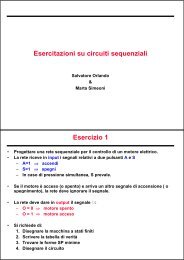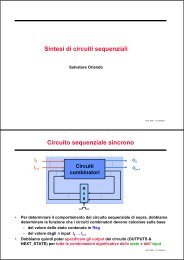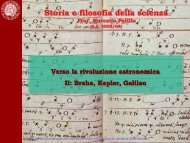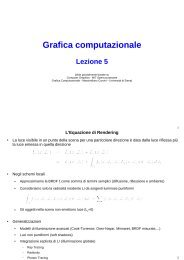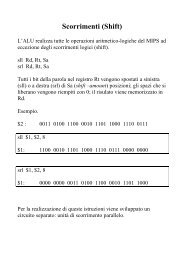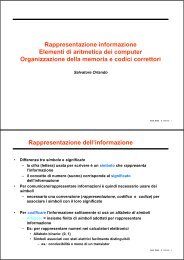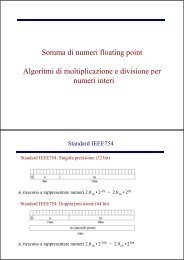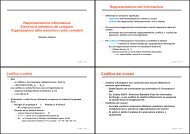A Neural-Symbolic Approach to the Contemporary Theory of Metaphor
A Neural-Symbolic Approach to the Contemporary Theory of Metaphor
A Neural-Symbolic Approach to the Contemporary Theory of Metaphor
Create successful ePaper yourself
Turn your PDF publications into a flip-book with our unique Google optimized e-Paper software.
<strong>Contemporary</strong> <strong>Theory</strong> <strong>of</strong> <strong>Metaphor</strong> Sets, Functions and Networks Example Applications and conclusion<br />
Philosophy and Machine Learning - Workshop<br />
(@ <strong>Neural</strong> Information Processing Systems 2011)<br />
A <strong>Neural</strong>-<strong>Symbolic</strong> <strong>Approach</strong><br />
<strong>to</strong> <strong>the</strong> <strong>Contemporary</strong> <strong>Theory</strong> <strong>of</strong> <strong>Metaphor</strong><br />
Guido Boella - University <strong>of</strong> Turin, Italy<br />
Artur d’Avila Garcez - City University, London<br />
Alan Perotti - University <strong>of</strong> Turin, Italy<br />
1 / 19
<strong>Contemporary</strong> <strong>Theory</strong> <strong>of</strong> <strong>Metaphor</strong> Sets, Functions and Networks Example Applications and conclusion<br />
The Classical <strong>Theory</strong> <strong>of</strong> <strong>Metaphor</strong><br />
Dates back <strong>to</strong> Aris<strong>to</strong>tle<br />
Do not go gentle in<strong>to</strong> that good night.<br />
Dylan Thomas<br />
<strong>Metaphor</strong>s: Instances <strong>of</strong> novel poetic language in which words<br />
(like go and night) are not used in <strong>the</strong>ir normal everyday sense.<br />
Defines metaphor as a matter <strong>of</strong> language<br />
Describes metaphorical expression as mutually exclusive with<br />
<strong>the</strong> realm <strong>of</strong> ordinary language<br />
2 / 19
<strong>Contemporary</strong> <strong>Theory</strong> <strong>of</strong> <strong>Metaphor</strong> Sets, Functions and Networks Example Applications and conclusion<br />
The <strong>Contemporary</strong> <strong>Theory</strong> <strong>of</strong> <strong>Metaphor</strong><br />
”The generalizations governing poetic metaphorical expressions are<br />
not in language, but in thought: <strong>the</strong>y are general mappings across<br />
conceptual domains. Moreover, <strong>the</strong>se general principles which take<br />
<strong>the</strong> form <strong>of</strong> conceptual mappings, apply not just <strong>to</strong> novel poetic<br />
expressions, but <strong>to</strong> much <strong>of</strong> ordinary everyday language. In short,<br />
<strong>the</strong> locus <strong>of</strong> metaphor is not in language at all, but in <strong>the</strong> way we<br />
conceptualize one mental domain in terms <strong>of</strong> ano<strong>the</strong>r. The general<br />
<strong>the</strong>ory <strong>of</strong> metaphor is given by characterizing such cross-domain<br />
mappings. And in <strong>the</strong> process, everyday abstract concepts like<br />
time, states, change, causation, and purpose also turn out <strong>to</strong> be<br />
metaphorical.”<br />
[G. Lak<strong>of</strong>f, The <strong>Contemporary</strong> <strong>Theory</strong> <strong>of</strong> <strong>Metaphor</strong>]<br />
3 / 19
<strong>Contemporary</strong> <strong>Theory</strong> <strong>of</strong> <strong>Metaphor</strong> Sets, Functions and Networks Example Applications and conclusion<br />
The <strong>Contemporary</strong> <strong>Theory</strong> <strong>of</strong> <strong>Metaphor</strong><br />
We’ve hit a dead-end street<br />
We can’t turn back now<br />
Love IS A journey<br />
We‘re driving in <strong>the</strong> fast lane on <strong>the</strong> freeway <strong>of</strong> love<br />
Relationship AS vehicle<br />
Lovers AS passengers<br />
Alternatives AS crossroads<br />
4 / 19
<strong>Contemporary</strong> <strong>Theory</strong> <strong>of</strong> <strong>Metaphor</strong> Sets, Functions and Networks Example Applications and conclusion<br />
Source and target domain<br />
T S<br />
x<br />
y<br />
f T ?<br />
f T (x)?<br />
a<br />
b<br />
f S<br />
5 / 19
<strong>Contemporary</strong> <strong>Theory</strong> <strong>of</strong> <strong>Metaphor</strong> Sets, Functions and Networks Example Applications and conclusion<br />
Mapping over domains<br />
T S<br />
x<br />
y<br />
m<br />
n<br />
a<br />
b<br />
f S<br />
T S<br />
n(f S (m(x))=y f T (x) = y<br />
x<br />
y<br />
f T<br />
a<br />
b<br />
f S<br />
6 / 19
<strong>Contemporary</strong> <strong>Theory</strong> <strong>of</strong> <strong>Metaphor</strong> Sets, Functions and Networks Example Applications and conclusion<br />
The Mapping<br />
Given two algebraic structures A and B, a function m is a<br />
monomorphism iff:<br />
m is injective<br />
∀ n-ary operation f over <strong>the</strong> structures, ∀ n-tuple x1, .., xn <strong>of</strong><br />
A, m(fA(x1, .., xn)) = fB(m(x1), .., m(xn))<br />
where fA and fB represent f over A and B respectively.<br />
In our setting, we can’t compute fA, and we wonder what could<br />
fA(x1, .., xn) be. Since m is injective, it can be inverted. Let n be<br />
<strong>the</strong> inverse function <strong>of</strong> m. The following transformations hold:<br />
fA(x1, .., xn) ≡ 1 n(m(fA(x1, .., xn))) ≡ 2 n(fB(m(x1), .., m(xn)))<br />
Where (≡ 1 ) is justified because m and n are inverse functions<br />
(and <strong>the</strong>refore n(m(x)) ≡ x) and (≡ 2 ) follows from <strong>the</strong> definition<br />
<strong>of</strong> monomorphism.<br />
7 / 19
<strong>Contemporary</strong> <strong>Theory</strong> <strong>of</strong> <strong>Metaphor</strong> Sets, Functions and Networks Example Applications and conclusion<br />
Knowledge representation and Learning<br />
The <strong>Neural</strong>-<strong>Symbolic</strong> paradigm<br />
We model <strong>the</strong> source and target domains as connectionist<br />
inductive learning and logic programming (CILP) system<br />
The CILP system ([1]) is a neural-symbolic system showing a<br />
one-<strong>to</strong>-one correspondence between logic programming and neural<br />
networks that are trainable by backpropagation.<br />
We model <strong>the</strong> mapping functions m and n as a single restricted<br />
Boltzmann machine (RBM). A RBM defines a probability<br />
distribution P(V=v,H=h) over pairs <strong>of</strong> vec<strong>to</strong>rs v and h encoded in<br />
<strong>the</strong>se layers, where v encodes <strong>the</strong> input data in binary or real<br />
values and h encodes <strong>the</strong> posterior probability P(H|v).<br />
8 / 19
<strong>Contemporary</strong> <strong>Theory</strong> <strong>of</strong> <strong>Metaphor</strong> Sets, Functions and Networks Example Applications and conclusion<br />
Architecture<br />
?<br />
T S<br />
x<br />
y<br />
m<br />
n<br />
n(f S (m(x))=y<br />
a<br />
b<br />
f S<br />
9 / 19
<strong>Contemporary</strong> <strong>Theory</strong> <strong>of</strong> <strong>Metaphor</strong> Sets, Functions and Networks Example Applications and conclusion<br />
Source domain<br />
Find o<strong>the</strong>r<br />
Reverse Put gas<br />
path<br />
R1<br />
Dead-end<br />
road<br />
R2<br />
Wrong<br />
turn<br />
R3 R4<br />
Low on<br />
gas<br />
10 / 19
<strong>Contemporary</strong> <strong>Theory</strong> <strong>of</strong> <strong>Metaphor</strong> Sets, Functions and Networks Example Applications and conclusion<br />
Mapping<br />
Dead-end<br />
road<br />
No<br />
promotions<br />
Reverse<br />
Apply<br />
for a job<br />
Wrong<br />
turn<br />
Resign<br />
Find o<strong>the</strong>r<br />
path<br />
Volunteer<br />
for<br />
overtime<br />
Put<br />
gas<br />
Low<br />
on gas<br />
Low<br />
salary<br />
11 / 19
<strong>Contemporary</strong> <strong>Theory</strong> <strong>of</strong> <strong>Metaphor</strong> Sets, Functions and Networks Example Applications and conclusion<br />
Target domain<br />
Resign<br />
No<br />
promotions<br />
Apply for<br />
a job<br />
?<br />
Low<br />
salary<br />
Volunteer<br />
for overtime<br />
12 / 19
<strong>Contemporary</strong> <strong>Theory</strong> <strong>of</strong> <strong>Metaphor</strong> Sets, Functions and Networks Example Applications and conclusion<br />
Step one: mapping<br />
Dead-end<br />
road<br />
No<br />
promotions<br />
Reverse<br />
Apply<br />
for a job<br />
Wrong<br />
turn<br />
Resign<br />
Find o<strong>the</strong>r<br />
path<br />
Volunteer<br />
for<br />
overtime<br />
Put<br />
gas<br />
Low<br />
on gas<br />
Low<br />
salary<br />
13 / 19
<strong>Contemporary</strong> <strong>Theory</strong> <strong>of</strong> <strong>Metaphor</strong> Sets, Functions and Networks Example Applications and conclusion<br />
Step two: computing<br />
Find o<strong>the</strong>r<br />
Reverse Put gas<br />
path<br />
R1<br />
Dead-end<br />
road<br />
R2<br />
Wrong<br />
turn<br />
R3 R4<br />
Low on<br />
gas<br />
14 / 19
<strong>Contemporary</strong> <strong>Theory</strong> <strong>of</strong> <strong>Metaphor</strong> Sets, Functions and Networks Example Applications and conclusion<br />
Step three: mapping back<br />
Dead-end<br />
road<br />
No<br />
promotions<br />
Reverse<br />
Apply<br />
for a job<br />
Wrong<br />
turn<br />
Resign<br />
Find o<strong>the</strong>r<br />
path<br />
Volunteer<br />
for<br />
overtime<br />
Put<br />
gas<br />
Low<br />
on gas<br />
Low<br />
salary<br />
15 / 19
<strong>Contemporary</strong> <strong>Theory</strong> <strong>of</strong> <strong>Metaphor</strong> Sets, Functions and Networks Example Applications and conclusion<br />
Step four: learning<br />
Resign<br />
R1<br />
No<br />
promotions<br />
Apply for<br />
a job<br />
!<br />
Low<br />
salary<br />
Volunteer<br />
for overtime<br />
16 / 19
<strong>Contemporary</strong> <strong>Theory</strong> <strong>of</strong> <strong>Metaphor</strong> Sets, Functions and Networks Example Applications and conclusion<br />
Applications<br />
Knowledge (and reasoning patterns) recycling<br />
S<strong>of</strong>tware reuse and encapsulation<br />
Blackbox use via interfaces<br />
Commitment-based multiagent interaction<br />
17 / 19
<strong>Contemporary</strong> <strong>Theory</strong> <strong>of</strong> <strong>Metaphor</strong> Sets, Functions and Networks Example Applications and conclusion<br />
Conclusions<br />
In this work, we model <strong>the</strong> cognitive <strong>the</strong>ory <strong>of</strong> metaphor, as<br />
defined by Lak<strong>of</strong>f, as a monomorphism. With this approach we are<br />
able <strong>to</strong> prove that local computation can be performed over a more<br />
familiar domain. We propose a framework that relies on <strong>the</strong> CILP<br />
system and RBMs and allows <strong>to</strong> perform learning and reasoning<br />
over unknown domains.<br />
18 / 19
<strong>Contemporary</strong> <strong>Theory</strong> <strong>of</strong> <strong>Metaphor</strong> Sets, Functions and Networks Example Applications and conclusion<br />
Thank you.<br />
References:<br />
1 A. d’Avila Garcez, K. B. Broda, and D. M. Gabbay.<br />
<strong>Neural</strong>-<strong>Symbolic</strong> Learning Systems. Per- spectives in <strong>Neural</strong><br />
Computing. Springer, 2002.<br />
2 L. de Penning, A. S. d’Avila Garcez, L. C. Lamb, and J.-J. C.<br />
Meyer. A neural-symbolic cogni- tive agent for online learning and<br />
reasoning. In IJCAI, pages 1653–1658, 2011.<br />
3 G. E. Hin<strong>to</strong>n. Training products <strong>of</strong> experts by minimizing contrastive<br />
divergence. <strong>Neural</strong> Com- put., 14:1771–1800, August 2002.<br />
4 G. Lak<strong>of</strong>f. The <strong>Neural</strong> <strong>Theory</strong> <strong>of</strong> <strong>Metaphor</strong> and Thought, page<br />
17–39. Cambridge University Press, Cambridge, 2008.<br />
5 G. Lak<strong>of</strong>f and M. Johnson. <strong>Metaphor</strong>s we Live by. University <strong>of</strong><br />
Chicago Press, Chicago, 1980.<br />
6 P. Smolensky. Information processing in dynamical systems:<br />
foundations <strong>of</strong> harmony <strong>the</strong>ory, pages 194–281. MIT Press,<br />
Cambridge, MA, USA, 1986. 19 / 19



